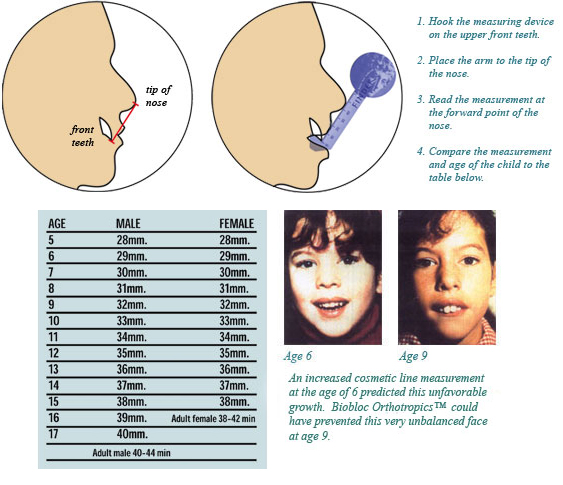Diagnosing Your Child
Early detection is an essential part of the Orthotropic treatment process, as is any health approach.
Prevention is better than cure
The Orthotropic method emphasizes the importance of early detection and treatment because of the rapidly stiffening nature of facial bones between the ages of 7 and 10.
Treatment is best completed while baby teeth are still in place, what is known as the mixed dentition. Early adolescent patients tend to be less disciplined and are more socially conscious, often refusing to wear appliances and complete the prescribed muscle strengthening exercises.
For the best results and care, children should begin treatment by age 7 but preferably before 10 years of age.
We encourage you to evaluate your child’s situation by age 6 or younger.
As a general guide, you can make a simple assessment by measuring the distance from the tip of the upper front teeth to the tip of the nose. Dr. Mew calls it the "Indicator Line", a linear measurement from the biting edge of the upper front teeth to the tip of the nose. The ideal for the cosmetic line or " indicator line" is the age of the person plus 23. This millimeter measurement varies only slightly with body size. An increase of 5 mm or more from these standards indicates undesirable facial growth.
So at 5 years of age this should be 28 mm or 29 mm at 6 years and should increase 1 mm per year.

What to look for.......
Read this article for a thorough understanding.
CHAPTER 4 READING THE FACE The-Cause-Of-Malocclusion-…
There are several other early indicators of malocclusion ( Bad Bite) or poor facial development to help you diagnose your child:
-No space between the front baby teeth
-A gummy smile
-Uneven or poorly aligned lower front permanent teeth
-Loose skin beneath the eyes (i.e. shadowing) or bags under the eyes and flat cheekbones
-Set back upper or lower jaw with an open mouth posture
-Thumb sucking
-Mouth breathing
-Snoring
-Tooth grinding
-Flat cheeks
-Poor body posture
-Tongue Tie
-and Sleep posture more Click here
